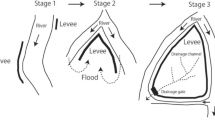Abstract
The Kabu-ido system was a customary groundwater management practice that was once used in the southern part of Noubi Plain in the Tokai area of Japan. The system had two features: limitation of the total number of wells and groundwater users’ obligation to pay economic compensation. From the theoretical point of view, it is an example of the Coase theorem, because it can be regarded as an institution by which the stakeholders internalized negative externalities caused by groundwater pumping through private negotiations. Although the Kabu-ido system is not used any more, it still contains implications for current groundwater management policy including the importance of third-party monitoring, usefulness of issue linkage in the process of conflict management, effectiveness of economic tools on the use of groundwater pumping restrictions, and significance of an ear-marked tax.
Access this chapter
Tax calculation will be finalised at checkout
Purchases are for personal use only
Similar content being viewed by others
References
Andoh M (1975) Ring-levee: the development and structure. Kokonshoin, Tokyo (in Japanese)
Bekki A (1932) A geographical study on ring-levees in Seino plain. Collect Essays Geogr 1:230–282 (in Japanese)
Coase RH (1960) The problem of social cost. J Law Econ 3:1–44
Endo T (2011) Sinking cities and governmental action: institutional responses to land subsidence in Osaka and Bangkok. In: Taniguchi M (ed) Groundwater and subsurface environments: human impacts in Asian coastal cities. Springer, Tokyo, pp 271–288
Editorial Committee of a History of Wanouchi Town (1981) A history of Wanouchi town (in Japanese)
Hardin G (1968) The tragedy of the commons. Science 162:1243–1248
Hirata Town (1984) A history of Hirata town, a book of the historical documents (in Japanese)
Ikeda Y, Hayashiya T (1964) Tokyo and Osaka. Shibundo, Tokyo (in Japanese)
Ito Y, Aoki N (1987) Ring-levee. Gakuseisha, Tokyo (in Japanese)
Ito Y (2001) Ring-levee and the characteristic. In: Gifu Prefecture Museum (ed) Ring-levee and flood control, Japan, pp 2–7 (in Japanese)
Itoh Y (2002) Conflict and customary solution on drainage water, Kisso (magazine published by local construction office of lower Kiso River Basin, Chubu Regional Bureau, Ministry of Land, Infrastructure and Transport, Japan), vol 43, pp 9–10 (in Japanese)
Katizu Educational Committee (2009) Growing ring-levee (in Japanese)
Kaizu Town (1970a) A history of Kaizu town, a book on the folklore (in Japanese)
Kaizu Town (1970b) A history of Kaizu town, a book on the historical documents (in Japanese)
Katano A (1941) The Kabu-ido system in Fukuzuka and Takasu ring-levees. Noubi Culture 1:47–77 (in Japanese)
Matsubara Y (1968) On the development of ‘Kabu-ido,’ authorized artesian wells for irrigation in Takasu-wadju of Nobi Plain. Geogr Rev Jpn 41(8):491–504 (in Japanese)
Matsuo K (1993) A study on history of ring-levee in Noubi area, a revised and enlarged edition. Taishu Shobou, Gifu (in Japanese)
Miyamoto M (1977) A study on Kabu group. Koudansha, Tokyo (in Japanese)
Mori G (1964) A history of Hirata town, the second volume (in Japanese)
Nakazawa B, Akiyama K, Yamada K (1936) A history and geography of ring-levee villages. Research Institute of Japanese Agricultural Villages, Tokyo (in Japanese)
Nanno Town (1978) A history of Nanno town (in Japanese)
Scitovsky T (1954) Two concepts of external economy. J Polit Econ 62:143–151
Shibazaki T (1981) A new dimensions of groundwater uses and conservation. In: Current topics of water issues, the task and perspective, (special number of Jurist), pp 57–64 (in Japanese)
Wanouchi Town (1991) Oogure River (in Japanese)
Yourou Town (1978) A history of Yourou town, the first volume (in Japanese)
Historical Documents of the Kabu-ido System
Documents of Flood Control Office, Kasamatsu-jinya, Mino-gundai (1854a) Petition to destroy wells in Takasu ring-levee
Documents of Flood Control Office, Kasamatsu-jinya, Mino-gundai (1854b) Note on monitoring for harm by artesian wells in Takasu ring-levee
Documents of Flood Control Office, Kasamatsu-jinya, Mino-gundai (1854c) Petition to use artesian wells
Documents of Flood Control Office, Kasamatsu-jinya, Mino-gundai (1854d) Survey of artesian wells in Takasu ring-levee
Documents of Flood Control Office, Kasamatsu-jinya, Mino-gundai (1855) Petition to stop artesian wells
Documents of Flood Control Office, Kasamatsu-jinya, Mino-gundai (1860a) Agreement between the upper and lower villages on the use of artesian wells in Takasu ring-levee
Documents of Flood Control Office, Kasamatsu-jinya, Mino-gundai (1860b) Testimony by villages on the use of artesian wells in Takasu ring-levee
Documents of Flood Control Office, Kasamatsu-jinya, Mino-gundai (1861) Survey of working wells and abandoned wells
Documents of Flood Control Office, Kasamatsu-jinya, Mino-gundai (1873) Survey of artesian wells in Takasu ring-levee in 1873
Acknowledgments
This work was financially supported by KAKENHI (Grants-in-Aid for Scientific Research, Grant-in-Aid for Young Scientists (B)) of Japan Society for the Promotion of Science (Project No. 22710050), the “Long-term Vision for the Sustainable Use of the World’s Freshwater Resources” program through Core Research for Evolutional Science and Technology (CREST) under the Japan Science and Technology Agency and the Asahi Glass Foundation.
All the historical documents on the Kabu-ido system cited in this chapter (Documents of Flood Control Office, Kasamatsu-jinya, Mino-gundai) are available in the Gifu Prefecture historical document center. The views presented here are those of the author and should not be attributed to Gifu Prefecture in any way. Responsibility for the text (with any surviving errors) rests entirely with the author.
Author information
Authors and Affiliations
Corresponding author
Editor information
Editors and Affiliations
Rights and permissions
Copyright information
© 2014 Springer Japan
About this chapter
Cite this chapter
Endo, T. (2014). The Kabu-ido System: Implications for Current Groundwater Management Policy. In: Taniguchi, M., Hiyama, T. (eds) Groundwater as a Key for Adaptation to Changing Climate and Society. Global Environmental Studies. Springer, Tokyo. https://doi.org/10.1007/978-4-431-54968-0_8
Download citation
DOI: https://doi.org/10.1007/978-4-431-54968-0_8
Published:
Publisher Name: Springer, Tokyo
Print ISBN: 978-4-431-54967-3
Online ISBN: 978-4-431-54968-0
eBook Packages: Earth and Environmental ScienceEarth and Environmental Science (R0)



